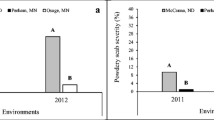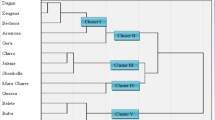Abstract
Potato resistance to powdery scab, caused by the protist Spongospora subterranea f.sp. subterranea, has become extremely important in recent years due to the increased damage caused by this disease. Since field conditions cannot be controlled, they are sometimes sub-optimal for scab susceptibility detection. Thus, a greenhouse assay has been developed that consistently provides optimal conditions so that the susceptibility potential of a clone in the field can be efficiently evaluated. Four potato cultivars were evaluated which varied in levels of powdery scab susceptibility. Two soil types and three inoculum levels were also evaluated. Other factors, such as soil temperature and moisture, were examined to make certain that a range ideal for powdery scab development as reported in current literature was obtained. These greenhouse results were compared with three years of field data collected from trials conducted in the San Luis Valley, Colorado, USA. Each of the cultivars was evaluated for root galling, tuber lesion incidence, and severity. Greenhouse results most consistently matched field results when potatoes were planted in a soil with 50% sand, an inoculum level of one sporeball per gram, and high irrigation coupled with appropriate soil temperatures (ranging from 10–18°C) during the tuber initiation to bulking phase. This soil mix was utilized to test 14 cultivars in the greenhouse with varying levels of resistance to powdery scab. When greenhouse results were correlated with field results a pattern emerged which demonstrated that the cultivars were accurately ranked based on susceptibility to scab (e.g., cultivars with the most resistance to scab in the field also showed the most resistance in the greenhouse). A conversion table using the greenhouse score was developed to estimate the potential susceptibility of a clone under optimum field conditions. Results demonstrate that a greenhouse assay can be successfully used for evaluating advanced potato germplasm for resistance to powdery scab.
Resumen
La Resistencia de la papa a la roña polvorienta, causada por la protista Spongospora subterranea f. sp. subterranea, se ha vuelto extremadamente importante en los años recientes debido al daño en aumento causado por esta enfermedad. Considerando que las condiciones de campo no pueden ser controladas, a veces son sub-óptimas para la detección de la susceptibilidad a la roña. Por lo anterior, se ha desarrollado un ensayo de invernadero que proporciona condiciones óptimas consistentemente, de manera que puede ser evaluada eficientemente la susceptibilidad potencial de un clon en el campo. Se evaluaron cuatro cultivares de papa que variaron en sus niveles de susceptibilidad. También se evaluaron dos tipos de suelo y tres niveles de inoculo. Se examinaron otros factores, tales como temperatura y humedad del suelo, para asegurar que se obtuviera una amplitud ideal de desarrollo de la roña polvorienta como se ha reportado en la literatura actual. Se compararon estos resultados de invernadero con datos de tres años colectados de ensayos desarrollados en el valle de San Luis, Colorado, E.U.A. Cada cultivar se evaluó para agallas de la raíz, incidencia de lesión de tubérculo y severidad. Los resultados de invernadero coincidieron consistentemente en la mayoría de las veces con los de campo cuando las papas se plantaron en un suelo con 50% de arena, y un nivel de inoculo de una bola de esporas por gramo, y riego pesado, acompañado con temperaturas apropiadas del suelo (variando de 10–18°C) durante la fase de iniciación a llenado de tubérculo. Esta mezcla de suelo se utilizó para probar 14 cultivares en el invernadero con variación en los niveles de resistencia a la roña polvorienta. Cuando se correlacionaron los resultados del invernadero con los de campo surgió un patrón que demostró que los cultivares fueron clasificados con precisión en su susceptibilidad a la roña (p.e. los cultivares con la mayor resistencia a la roña en el campo también la mostraron en el invernadero). Se desarrolló una tabla de conversión utilizando las calificaciones del invernadero para estimar la susceptibilidad potencial de un clon bajo condiciones óptimas en el campo. Los resultados demuestran que un ensayo de invernadero puede usarse con éxito para la evaluación de germoplasma de papa avanzado para la resistencia a la roña polvorienta.








Similar content being viewed by others
References
Baldwin, S.J., R.A. Genet, R.C. Butler, and J.M.E. Jacobs. 2008. A greenhouse assay for powdery scab (Spongospora subterranea f.sp. subterranea) resistance in potato. Potato Research 51: 163–173.
Braithwaite, M., R.E. Falloon, R.A. Genet, A.R. Wallace, J.D. Fletcher, and W.F. Braam. 1994. Control of powdery scab of potatoes with chemical seed tuber treatments. New Zealand Journal of Crop and Horticultural Science 22: 121–128.
Christ, B.J. 2005. Integrated management of powdery scab. Proceedings of Wisconsin’s Annual Potato Meeting. University of Wisconsin-Madison Extension, Wisconsin Agricultural Experiment Station.
de Boer, R. 1991. Evaluation of potato cultivars in the greenhouse and field for resistance to powdery scab. Australian Journal of Experimental Agriculture 31: 699–703.
Douches, D.S. 2005. Breeding and genetics for the improvement of potato (Solanum tuberosum L.) for yield, quality, and pest resistance. http://www.msu.edu/user/douchesd/overview/overview.html. Accessed 28 September 2005.
Falloon, R.E., R.A. Genet, A.R. Wallace, and R.C. Butler. 2003. Susceptibility of potato (Solanum tuberosum) cultivars to powdery scab (caused by Spongospora subterranea f. sp. subterranea), and relationships between tuber and root infection. Australasian Plant Pathology 32: 377–385.
Harrison, J.G., R.J. Searle, and N.A. Williams. 1997. Powdery scab disease of potato - a review. Plant Pathology 46: 1–25.
Holm, D.G. 2005. The search for new potato cultivars. http://www.SLVRC.colostate.edu/searchforpotcult.html. Accessed 28 September 2005.
Jellis, G.J., P.S. Phul, and N.C. Starling. 1987. Evaluation of potato germplasm for resistance to powdery scab (Spongospora subterranea). Annals of Applied Biology 110 (Supplement). Tests of Agrochemicals and Cultivars 8: 154–155.
Lees, A.K., P. van de Graaf, and S. Wale. 2008. The identification and detection of Spongospora subterranea and factors affecting infection and disease. American Journal of Potato Research 85: 247–252.
Merz, U. 2000. Powdery scab research in Switzerland. In: Proceedings First European Powdery Scab Workshop, SAC, Aberdeen, Scotland, July 20–22, 2000, eds. Mertz U, Lees AK.
Merz, U., and R.E. Falloon. 2009. Review: powdery scab of potato – increased knowledge of pathogen biology and disease epidemiology for effective disease management. Potato Research 52: 17–37.
Merz, U., V. Martinez, and R. Schwarzel. 2004. The potential for the rapid screening of potato cultivars (Solanum tuberosum) for resistance to powdery scab (Spongospora subterranea) using a laboratory bioassay. European Journal of Plant Pathology 110: 71–77.
Miller, J. 2001. Powdery scab workshop - summary notes. Alamosa, CO January 11, 2001. http://www.uidaho.edu/ag/plantdisease/scabnote.htm. Accessed 9 June 2005.
Taylor, P.A., S.P. Flett, R.F. de Boer, and D. Marshall. 1986. Effects of irrigation regimes on powdery scab disease and yield of potatoes. Australian Journal of Experimental Agriculture 26: 745–750.
van de Graaf, P., A.K. Lees, and J.M. Duncan. 2000. Epidemiology and control of Spongospora subterranea f. sp. subterranea, with special reference to zoospore release and bait plant infection. In: Proceedings First European Powdery Scab Workshop, SAC, Aberdeen, Scotland, July 20–22, 2000, eds. Mertz U, Lees AK.
van de Graaf, P., A.K. Lees, and J.M. Duncan. 2002. Effect of inoculum level and environmental conditions on powdery scab and root galling in potato. Proceedings Crop Protection in Northern Britian 2002. Dundee, UK: Scottish Crop Research Institute. pp 281–286.
van de Graaf, P., A.K. Lees, S.J. Wale, and J.M. Duncan. 2005. Effect of soil inoculum level and environmental factors on potato powdery scab caused by Spongospora subterranea. Plant Pathology 54: 22–28.
Wale, S. 2001. The a to z of powdery scab and its control. Presentation given at the Potato Disease Workshop on Powdery Scab, coordinators R Zink and R Davidson, Alamosa CO, 11 January 2001.
Zink, R.T., R.D. Davidson, and A. Houser. 2004. Control strategies for powdery scab of potato. American Journal of Potato Research: Abstracts 81: 95–96.
Acknowledgements
The authors would like to thank Dr. Fahrettin Goktepe, Jim Zumbrunnen, and Dr. Phil Chapman for help with the statistical analysis. Locations for conducting field trials were provided by Worley seed, Lynn McCullough and Mike Mitchell and also the SLV Research Center provided the potato seed for this project. Funding for this project was primarily provided by the Colorado Potato Administrative Committee (CPAC).
Author information
Authors and Affiliations
Corresponding author
Rights and permissions
About this article
Cite this article
Houser, A.J., Davidson, R.D. Development of a Greenhouse Assay to Evaluate Potato Germplasm for Susceptibility to Powdery Scab. Am. J. Pot Res 87, 285–298 (2010). https://doi.org/10.1007/s12230-010-9136-5
Published:
Issue Date:
DOI: https://doi.org/10.1007/s12230-010-9136-5




